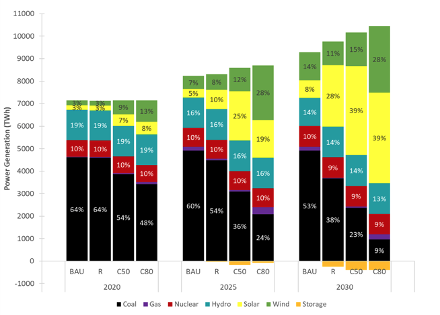Power
A clean-power future benefits the U.S., China and the world
Power
The China Energy Program conducts joint technical research, pilot demonstrations, and policy analysis on pathways to clean power system, power sector market reform, demand response (DR) and demand-side management (DSM), integration of renewable energy, distributed energy resources (DER), and microgrids with partners in both the U.S. and China.

Research Areas
In this research area, we assess technically feasible and economically viable pathways for transitioning to a zero-emissions power sector in China. One of our recent studies finds that more than 60% of China's electricity could come from non-fossil sources by 2030 at a cost that is about 10% lower than achieved through a business-as-usual approach (figure below), given rapid cost decrease of renewable energy technologies.
We have also examined the resource, economic, and institutional implications of reducing and replacing coal generation in China with mostly renewable energy by 2040. We find that, to do so, it will require a rapid scale-up of zero-emission resources, a transformation of planning, market, and regulatory institutions in its electricity sector, and a policy commitment to restrict investment in new coal generation after 2020.
The electricity market is likely to play an increasingly important role in more efficiently allocating resources, integrating renewable energy, and shaping future investment decisions as China considers its transition to a zero emission power system. In the area of power sector reform collaboration, our research, sponsored by the State Department’s Bureau of Energy Resources and others, focuses on relevant U.S. and Chinese experiences on renewable energy utilization, DR, and wholesale and retail market choices, with a view towards China's replicating/adopting lessons learned across provinces.
The activities included information-gathering on, sharing of international best practices, and visit/exchanges that explore current conditions and challenges in each pilot province/city, assessing specific pilot challenges, recommendations, and joint development of policy recommendations on the pilots and broader, market-opening reforms in China's power sector. Some of our recent studies have examined the economic and environmental benefits of the electricity market in China’s southern grid region and the Guangdong province. Our recent collaborative research also examined the need to coordinate the Chinese carbon market and the renewable certificate market.
The China Energy Program works closely with China National Energy Administration (NEA) on its microgrid and distribution generation policies. During the 12th Five Year Plan, Berkeley Lab worked with NAE’s affiliated Chinese institutes to develop a microgrid development technical guidance and policy recommendation for microgrid demonstration projects. The U.S. and international microgrid experience was extracted and analyzed as an example for China to develop its own policy.
During the 13th FYP, based on LBNL and its partners’ policy and technical research, NEA issued a policy to build nationwide “Internet+ Smart Energy DemonstrationsProject”. We are working with China to conduct benefits analysis of microgrid demonstration projects. We are also using Berkeley Lab's Distributed Energy Resource Customer Adoption Model (DER-CAM) and District Energy Planning (DEEP) to help optimize design and operation of microgrids, especially in building and campus.
LBNL also actively integrates microgrid research with other smart grid areas such as demand response. Research showed that a demand response enabled microgrid can dispatch clean energy efficiently and bring benefits to the microgrid and the whole power grid.
Demand-side management (DSM) has been one of the areas of China's electric power research that we have focused on. In recent years, our focus has been on improving grid flexibility through demand response (DR) and demand-side resources. LBNL researchers have been studying international best practices and effective mechanisms to promote development of DR. We have also conducted joint end-to-end DR automation testing to demonstrate the integration of utility DR management systems, DR products, and end-use control sequences with standards-based DR signals to accelerate acceptance of manufactured DR products in both countries (sponsored by Department of Energy’s Office of Electricity).
LBNL worked with State Grid and Southern Power Grid through the U.S.-China Climate Change Working Group (CCWG) since 2013. In the CCWG platform, LBNL and its Chinese counterparts developed a smart grid benefit analysis method to calculate techno-economics of smart grid investment at power distribution level. A joint smart grid collaboration white paper is published. In recent CCWG collaboration, LBNL worked with State Grid and Southern Power Grid to test demand response technologies and protocols. The U.S. and Chinese partners tested typical demand response related technologies including: Variable Frequency Drive (VFD), Thermostat, Lighting and smart meters. Berkeley Lab tested DR performance in a typical building setup using its FLEXLAB® testbed.
In this area, we are also conducting studies to develop recommendations on enhancing DR value by integrating DR into power system dispatch procedures, maximizing DR potential through tapping opportunities beyond peak load management, and creating roles for load aggregators to deliver greater DR value. Our research in this area also focuses on examining how effective tariffs and compensation incentives help increase DR in the US and China. Recently, in collaboration with Chinese researchers, we have provided a series of recommendations for the formulation of China’s 14th Five-Year Plan demand-side management work plan.
A number of articles and research reports reflect our diverse research in this area, including: Integrated DR in intermittent wind power generation and local power energy demand; enabling demand response in district energy systems for energy retail and wholesale; sharing demand-side resources among multiple prosumers, applying frequency regulation demand response in industrial load and demand dispatch. Resilient modeling of community energy system integrated with demand response.